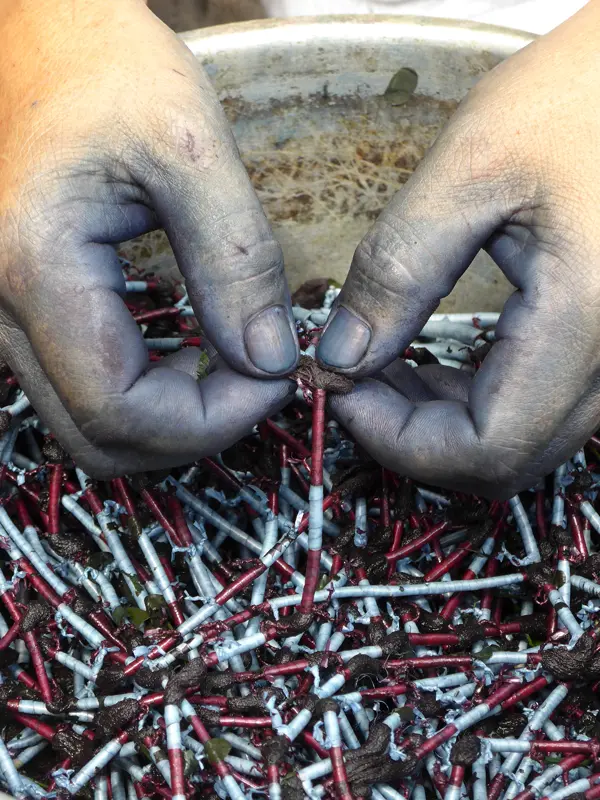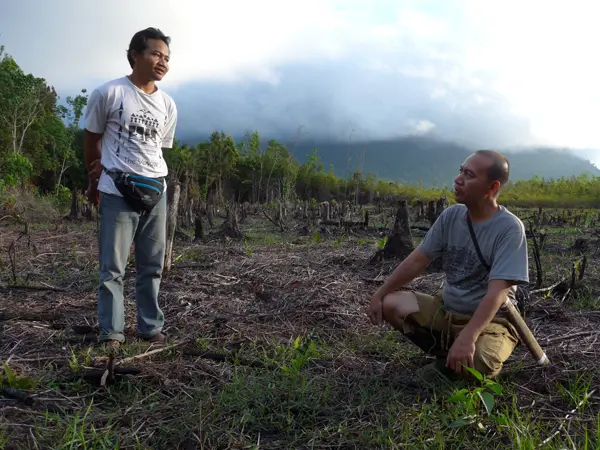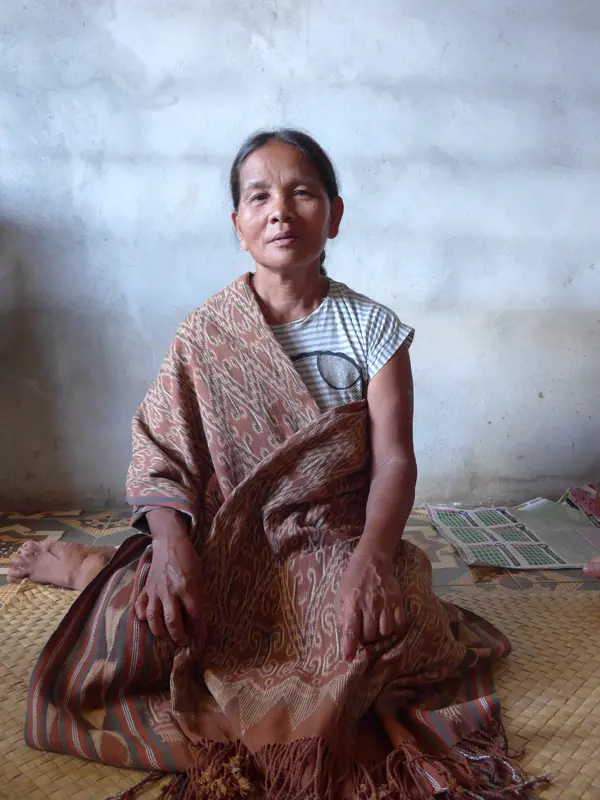Revitalization of a Kalimantan Art Form
It has been more than ten years since Threads of Life began to work in West Kalimantan with Dayak Desa weavers to help revive their art and their motivation to make traditional natural dyed textiles and other cultural art forms. Over this time the devastation of the forests has been beyond anything I could have imagined. The dire statistics are easy to find but what I need to find is how I feel about it. How do I deal with this tragedy that affects the whole world? What do the Dayak people do, whose identity is built on the life they made from these forests?

A healthy forest in West Kalimantan ten years ago

Shadows and light on open land in Sumba
In other areas where we work – Timor, Sumba, Savu – the desolate dry landscapes have existed for so long that I can look with eyes that see beauty in the play of light and shadows on the barren hills. But here in central West Kalimantan I can still remember green, majestic forests that are now mostly replaced with palm oil plantations. The oil palms are thirsty plants and entire river systems are now redirected to the plantations, leaving the small streams that villagers could bathe and swim in to run dry. Where a river once flowed under a wooden bridge leading to a village, the long boats that once carried people to fish and hunt lay on dry ground, their painters still tied hopefully to trees on the river bank.
I had not been to the Sintang area for seven years and the impact of seeing miles and miles of palm oil (kelapa sawit) plantations was numbing. We travelled with a group of basket makers from Sengkuang to gather materials from a small stand of old forest that has not yet been converted only because it is makam, an ancient graveyard. It remains a scrubby forest, but at least there is a presence.

Picking purun grasses to make baskets in a landscape that was forests not long ago

Foraging with local Dayaks for basket-making materials, including the jirnang seeds used to make a red color on bamboo
We walk with our Dayak friends to gather bright red jirnang seeds (Draconea carpa) which are boiled to extract a red dye used to rub onto the outside of bamboo as basket material. The bamboo is slit into smaller lengths and sharp knives remove the inner layers of fiber until only the thin outer-most red fiber layer remains.
What skill! And how effortlessly the women plait bamboo into a form. We were at a basket weaver’s house and, looking around the room, I could see five women involved in the basket work. There were other women working in neighbouring houses as well. “With no forest and no work, making baskets to sell to you is good money for us,” said one of the women I was sitting with.

Cupai bamboo woven baskets in process

Tied threads for a Kebat textile that have been dyed red and over-dyed with indigo to make them black
The loss of these forests has outlined Threads of Life’s primary work here. Our Dayak field staff Lius spends his days driving his motorbike to remote areas to work with basket weavers and small groups of textile weavers, helping them revive traditional dye recipes. Over the years, he has become a master dyer and is clearly respected by the women weavers.
With forests cleared it has become increasingly more difficult to find the materials to make natural dyes. Traditions that used to accompany these dye processes have also declined or disappeared all together. Threads of Life owns five hectares of land near Lius’s house where we will plant Morinda citrifolia, rotan, and jirnang, so that materials the local weavers and basket makers need can be sustainably harvested.

Threads of Life field staff manager Wenten with Dayak field staff Lius Talu

Lius is working with weavers to create a good oiling recipe for the threads prior to the red dye process
Over his time with us, Lius has received lengthy training with the Bebali Foundation dye team to understand the dye process, especially the complex oiling process prior to the red dye.
In the past the Dayak oil recipe required the use of many different plants, including varieties of oil seed which are now hard to find. Over time the recipes have been simplified to mostly use oils made of chicken, snake or lizard fat. Not only are these oils smelly but they do not contain the chemical composition to properly prepare cotton threads to be dyed Morinda red. The oil recipe has had to be re-calibrated and modified so that it is effective as a mordant while still honoring the ritual use of animal fats added in minute proportions.
Last December Lius spent two weeks in Bali at the Bebali Foundation dye studio experimenting and testing different combinations of the oils and materials used by Dayak weavers, trying to approximate the red color seen on old cloths that was color fast, not too oily, and maintained clear white areas with no dye running into it. “Those two weeks made such a difference,” Luis smiled while shaking his head. “It was like a light bulb went off and I knew what to do when I got back to Kalimantan.” In less than a year he has come closer than ever to achieving our shared goal: working with a weaver in Umin, a beautiful Dayak red kebat was made. A kebat is usually made into a woman’s tube skirt called a tape when left plain or tating when embellished with shells, beads, buttons or bells.
After eight years and very little financial return on our investment we have finally turned a corner in Kalimantan. Now that Lius has the garden we will be able to grow Morinda in large quantities for weavers and rattan for the basket makers so that there is a sustainable supply. At this time Threads of Life buys dried Morinda roots from a weaver in Sumba and ships it to Lius. This is hardly sustainable but a necessary stopgap while Lius grows his own Morinda trees. In the meantime, the original Dayak recipes have had to be adjusted from using fresh Morinda roots to using dried roots.

Creating a pua textiles with good color using proper proportions of oil and morinda red

Pua textiles wrapping daily offerings of food for the well-being of a son who has gone to work in Malaysia
When a longhouse burns down, sadly so do all the textiles. When a family needs money, old textiles are often the only source of income. In the past every Dayak Desa woman had a supply of red dyed pua blankets, but collectors have long coveted these. Today it is rare to see textiles still held by families. Master weaver Dilam showed us a textile from insider her cupboard. “I am saving this for my grandchild,” she told us. “I will not sell it as I want it to be part of his heritage and to remind him that his grandmother was a weaver.”
Two years ago when Lius came for his annual visit to Bali, we discussed how the motifs on the few textiles we were receiving from weavers were so clumsy as the ikat thread bundles had greatly increased in size compared to textiles woven by their grandmothers. The reason was not entirely about working more quickly to get money faster; it was more about having no samples left that weavers could use as examples. Regular photographs do not work well other than to act as a general reference, as the photo is usually too small to act as a guide. Instead, we photographed four old textiles that Lius identified as being Dayak Desa and had them blown up to actual textile size as posters that the weavers could work from. This has worked well and by last year the weavers were producing more refined textiles.

We created large poster-size images of old textiles to guide weavers new work

Master Dayak Desa weavers from Umin
I am encouraged today. I finally see the potential for reviving traditional natural dyed textiles in Kalimantan as we have seen on other islands where we work. It has reached that tipping point, when enough new textiles are being produced, generating significant income whereby the local population begins to take notice and interest – and with this a renewed pride in their culture begins to grow.

